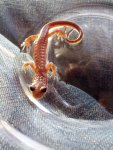MissManatee
New member
I have looked through the threads here and found some great info already. I'm just hoping for some extra advice and tips. I honestly couldn't find specific info for baby northwesterns, but if there's a thread I missed please link me.
I found this juvenile (?) salamander in my parade covered in dust and hairs and struggling. He's now in a tank with a vented lid. No other creatures.I bought newt and salamander food (probably useless for a wild salamander) and I've got frozen blood worms. I have him in a semi aquatic set up with gravel which also seems to be wrong...:He won't eat bloodworms so I'm thinking he needs live food..
Here is a link to some pics I posted on another site. I couldn't upload pics here using my phone. Maybe my wifi is too slow...
Pics here: I found this little creature in my parking garage. What is he?? - Imgur
Any tips for what I could feed this young guy? He seems too small for crickets... Small worms from the pet store? Ideal set up for northwestern juvenile? Is it necessary to hibernate him - a link on how when he's so young? And any other tips would be SO appreciated.
He's so cute. I want him to live a long time. (his name is George)
Additional info: I live in Coquitlam, BC in Canada.
I found this juvenile (?) salamander in my parade covered in dust and hairs and struggling. He's now in a tank with a vented lid. No other creatures.I bought newt and salamander food (probably useless for a wild salamander) and I've got frozen blood worms. I have him in a semi aquatic set up with gravel which also seems to be wrong...:He won't eat bloodworms so I'm thinking he needs live food..
Here is a link to some pics I posted on another site. I couldn't upload pics here using my phone. Maybe my wifi is too slow...
Pics here: I found this little creature in my parking garage. What is he?? - Imgur
Any tips for what I could feed this young guy? He seems too small for crickets... Small worms from the pet store? Ideal set up for northwestern juvenile? Is it necessary to hibernate him - a link on how when he's so young? And any other tips would be SO appreciated.
He's so cute. I want him to live a long time. (his name is George)
Additional info: I live in Coquitlam, BC in Canada.

